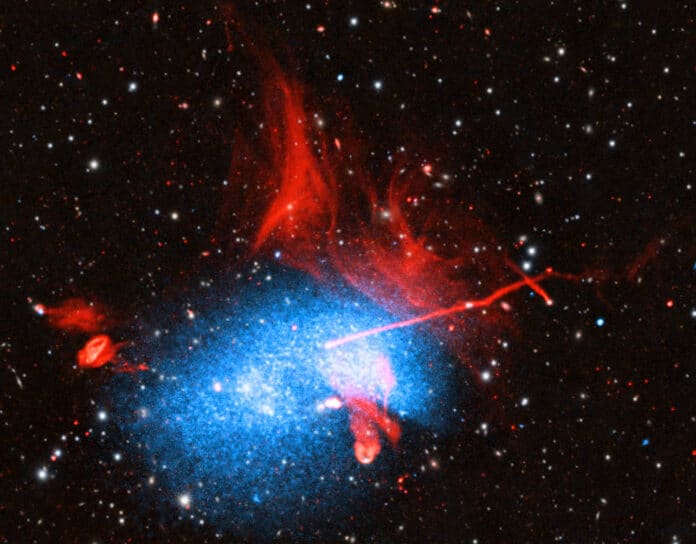Astronomers have observed a dramatic, continuing collision involving at least three galaxy clusters. Astronomers are using data from the Chandra X-ray Observatory of NASA, the XMM-Newton of the European Space Agency, and three radio telescopes to understand this chaotic spectacle.
These collisions and mergers are the primary mechanisms by which galaxy clusters might expand into the enormous cosmic structures we observe today. They serve as the biggest particle accelerators known to exist.
Abell 2256, a massive galaxy cluster developing due to this collision, is situated 780 million light-years from Earth. This composite image of Abell 2256 combines radio data from the Giant Metrewave Radio Telescope (GMRT), the Low-Frequency Array (LOFAR), and the Karl G. Jansky Very Large Array (VLA) in red with X-rays from Chandra and XMM in blue, as well as optical and infrared data from Pan-STARRs in white and pale yellow.
Astronomers investigating this object attempt to decipher this peculiar-appearing structure’s origin. The story is told differently via each telescope. Some of the largest objects in the universe are galaxy clusters, which comprise hundreds or even thousands of individual galaxies.
They also have vast gas reserves that are extremely hot, with temperatures reaching several million degrees Fahrenheit. X-ray telescopes like Chandra and XMM can only see this heated gas. A labeled version of the figure shows gas from two galaxy clusters, with the third blended too closely to separate from the others.
This system’s radio emission comes from a more intricate combination of sources. The first is the galaxies, whose supermassive black holes at their centers produce the radio signal by ejecting particles into space-time in jets.
These jets are either slowed down as they interact with the gas they are running into, forming intricate shapes and filaments (“A,” “B,” and “F”), or they are flying into space in straight, narrow lines (those named “C” and “I” in the annotated image, using the astronomer’s naming method).
Three sources are present in Source F, all of which were produced due to a black hole in a galaxy aligning with the middle source of this trio. Radio waves are also coming from huge filamentary structures (labeled “relic”), mostly located to the north of the radio-emitting galaxies, likely generated when the collision created shock waves and accelerated particles in the gas across over two million light-years.
Finally, a “halo” of radio emission is located near the collision’s center. Because this halo overlaps with the X-ray emission and is dimmer than the filamentary structure and the galaxies, another radio image has been produced to emphasize the faint radio emission.
In another paper, astronomers present a model that the halo emission may be caused by the reacceleration of particles by rapid changes in the temperature and density of the gas as the collision and merging of the clusters proceed. However, this model cannot explain all the features of the radio data, highlighting the need for the more theoretical study of this and similar objects.
Rajpurohit and colleagues’ Paper III will investigate the radio-emitting galaxies in Abell 2256. These galaxies are unusually abundant in this cluster, maybe due to the merger and collision fueling the expansion of supermassive black holes and their ensuing eruptions. Erik Osinga will publish more information regarding the LOFAR image of Abell 2256 in a future paper.
Journal Reference:
- K. Rajpurohit et al. Deep Low-frequency Radio Observations of A2256. I. The Filamentary Radio Relic. The Astrophysical Journal. DOI: 10.3847/1538-4357/ac4708
- K. Rajpurohit et al. Deep low-frequency radio observations of Abell 2256 II. The ultra-steep spectrum radio halo⋆. Astronomy and Astrophysics. DOI: 10.1051/0004-6361/202244925
